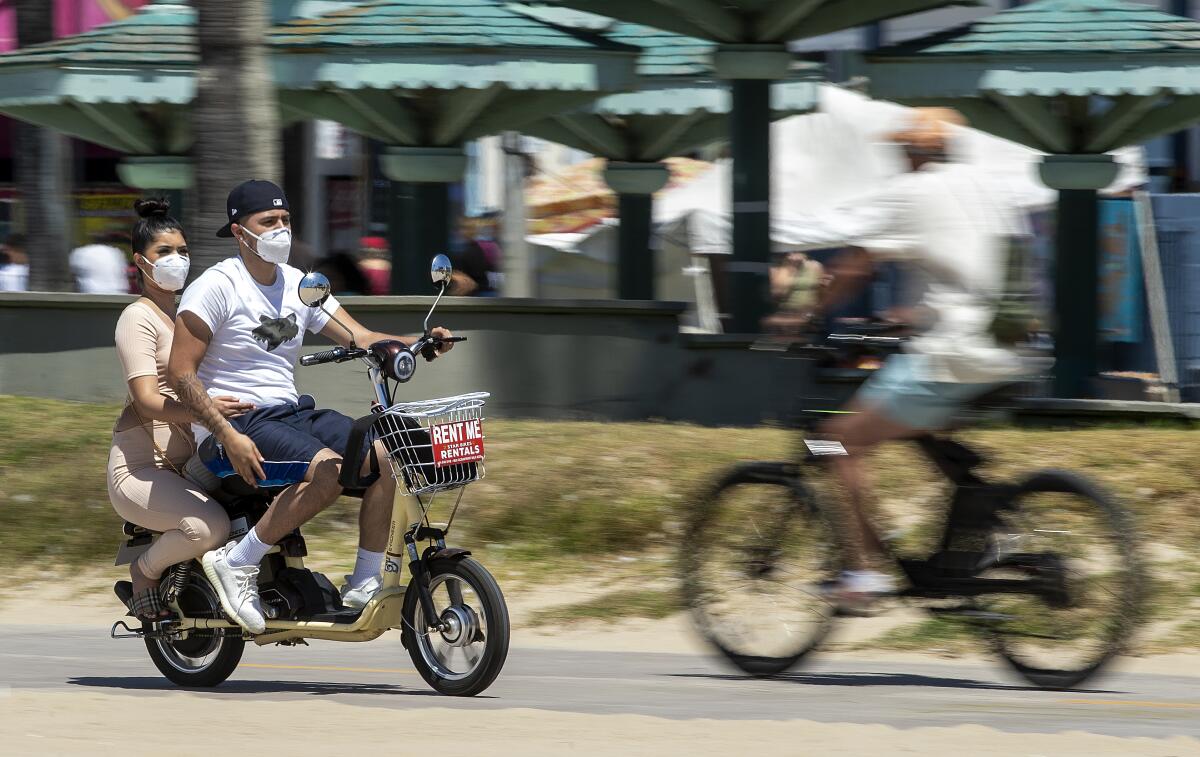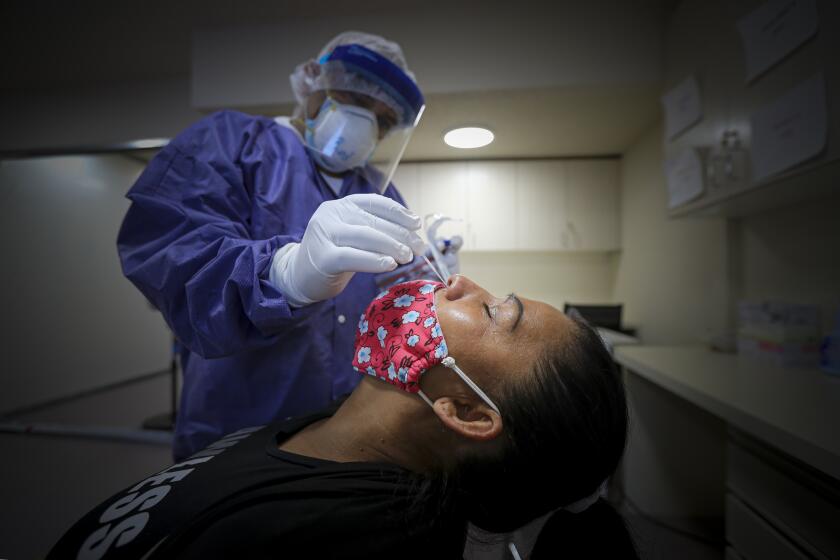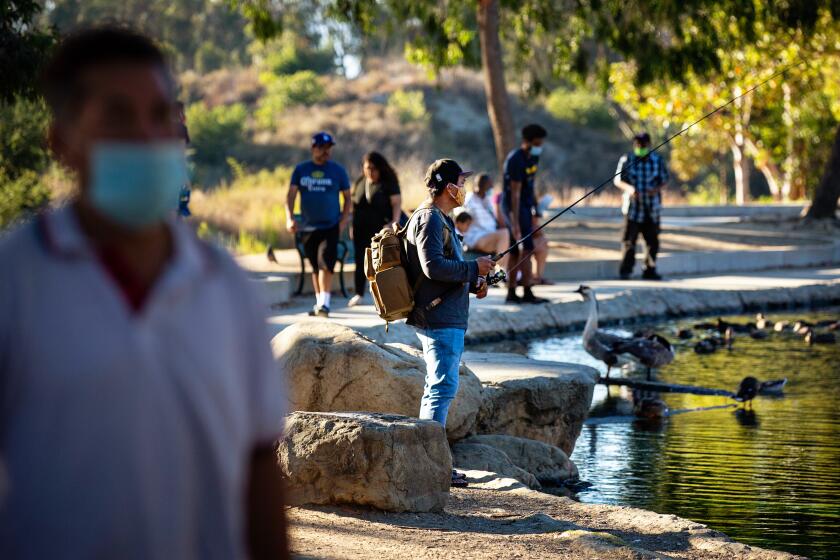California on the cusp of reining in COVID-19 surge, data show

- Share via
Six weeks after California began re-closing swaths of the economy, there is cautious optimism that coronavirus transmission is heading downward, officials said.
If it stays that way, the state may be on the cusp of curbing its second surge of the pandemic.
The potential crest comes after Gov. Gavin Newsom’s speedy economic reopening in May and early June led to a near doubling of the weekly death toll over the spring tally. California’s cumulative pandemic death toll is now about 11,000, one of the worst disasters in the state’s modern history.
But there are now several signs that Newsom’s second shutdown, which began in late June and broadened in early July, is finally having its intended effect. It can take three to five weeks to start seeing the health effects of stay-at-home orders, and six weeks have passed since much of the state was required to close bars and indoor dining rooms at restaurants, an order that was expanded to the rest of the state a month ago.
“While our gains might feel slow and our future remains fragile, our success over the last three weeks is real,” Los Angeles Mayor Eric Garcetti said Wednesday. “We begin to see signs of light.”
The mayor also announced that a coalition of scientific experts, bioscience firms, government leaders and foundations is researching at-home coronavirus testing in a bid to “accelerate the science” so that outbreaks can be identified more quickly.
In Los Angeles County, the effective transmission rate of the coronavirus is now about 0.86 — meaning that every one infected person passes the virus to an average of 0.86 other people. Last week, the rate was at 0.91.
“This is what progress looks like,” said Dr. Roger Lewis, who is leading L.A. County’s pandemic predictive modeling team.
Dr. Grant Colfax, San Francisco’s health director, said the transmission rate there was between 0.95 and 0.98 for the previous few days.
And statewide, an ensemble computer model known as the California COVID Assessment Tool estimates California’s overall transmission rate is about 0.96.
Epidemiologists and other public health experts said the only way to prevent more surges is to learn from past failure.
To be sure, not all counties are doing well. The state model estimates that Alameda, Sonoma, Placer and Inyo counties are seeing an increasing spread of the disease.
But hospitalizations are also falling in many regions of California. Statewide, the average number of people who were hospitalized seemed to peak in late July, when an average of nearly 7,000 people were in hospitals with confirmed coronavirus infections over a seven-day period; by Wednesday, that number had fallen to 5,710.
Deaths, however, have accelerated in recent weeks; in fact, more than 62% of California’s coronavirus deaths have occurred since Memorial Day.
For the seven-day period that ended Monday, 969 deaths were reported across California, the largest weekly death toll since the pandemic began.
It is possible that the number of new COVID-19 deaths may have peaked, but it’s probably too early to know for sure. By Wednesday, the seven-day average of daily deaths was 134, an improvement from the previous week, when the seven-day average hit 144, a record high.
“We are turning the corner on this pandemic,” Newsom said Wednesday.
The governor expressed optimism at the trend but resolved to avoid a reopening that repeated previous mistakes. Newsom, under pressure, began reopening businesses in late spring before his own benchmarks for a safer reopening were met.
“The worst mistake we can make … is run the 90-yard dash, where we think we’ve got this and we walk away, and we revert back to the way things used to be,” Newsom said Wednesday. “And that’s why we have to be very cautious and very deliberative.”
While hospitalizations rates decline, deaths are increasing and officials warn that Californians need to continue following safety protocols to prevent another wave of infections.
Newsom said that when the reopening of the economy does happen, it will be carried out “with much more focus, much more intention and more deliberative mindset” to educate people about how to diminish the spread of the disease.
“We have to maintain our vigilance,” Newsom said, “and we’ll need a commensurate public awareness campaign and enforcement campaign.”
In L.A. County, Public Health Director Barbara Ferrer said Wednesday that the rate of disease was still so high that colleges and universities would need to remain largely closed to in-person instruction until disease levels fall further, with limited exceptions such as lab work or arrangements for students who will become part of the essential workforce.
“The very nature of the way that colleges and universities operate creates a significant risk of outbreaks of COVID-19,” Ferrer said.
Social gatherings and workplace outbreaks caused a significant surge in the spread of disease after the economy was reopened in May and June.
A government analysis of all 188 documented coronavirus outbreaks in San Diego County showed that the total included 61 that occurred in restaurants or bars, 45 in various businesses and 18 in healthcare settings. Ten outbreaks occurred in government settings, nine in residences, eight in gyms, seven in faith-based settings, six in food-processing facilities, six in grocery facilities, five in hotels or resorts or spas, and four at preschools.
L.A. County has reported 30,827 new coronavirus cases in the last two weeks, which amounts to 305 new cases per 100,000 residents. The county will need to reduce that number to 200 new cases per 100,000 residents over a two-week period before local officials can contemplate allowing some elementary schools to reopen, and a rate of 100 new cases per 100,000 residents will be necessary to allow a further reopening of the economy.
Ferrer said she didn’t know when L.A. County would reach those levels but said it was possible; New York City has had a rate of about 50 cases per 100,000 residents in the last two weeks, she said. In other places in the world, with a “really concerted effort, that rate has come down and come down significantly,” she said.
Yet challenges remain.
L.A. County has filed a lawsuit seeking the closure of a church in Sun Valley, alleging that Grace Community Church of the Valley began holding indoor worship services July 26. Newsom ordered a prohibition of indoor worship services in the hardest-hit counties July 13; outdoor services are still allowed.
County officials said videos posted of religious services this month show congregants gathering without wearing masks or staying at least six feet from one another. The church issued a statement that said “compliance would be disobedience to our Lord’s clear commands.”
Some of the larger outbreaks in L.A. County include those identified at 10 UPS work sites in L.A., Bell, Gardena, Vernon, Cerritos, Sylmar, Van Nuys and elsewhere in which 84 workers have tested positive; and at the SoFi Stadium construction site in Inglewood, where 77 workers have tested positive.
At Trojan Battery Co. in Santa Fe Springs, 61 workers at two worksites have tested positive; three have been hospitalized, and one worker died, said L.A. County health officer Dr. Muntu Davis.
Cases remain high across Southern California. San Bernardino County has reported 350 new coronavirus cases per 100,000 residents in the last 14 days; Riverside County, 328; Ventura County, 211; Orange County, 207; and San Diego County, 155.
But to dramatically lower new infections, everyone needs to wear masks in public, businesses must comply with new coronavirus health and safety rules to protect workers, and residents need to stop hosting and attending parties, officials said. Young adults are increasingly getting infected and being hospitalized, a pattern seen across California.
“In June, the case rate among the young really began to take off,” said Dr. Sara Cody, the Santa Clara County health officer.
San Francisco Mayor London Breed said she wished she could have a party to celebrate her birthday Tuesday, but it’s clear that many people who are getting infected have contracted the virus at family gatherings, parties and other events.
So for her birthday, “I’m going to socially distance myself and talk to people on Zoom,” Breed told reporters. “And that’s what we need to do. Just imagine if we all did our part.”
Times staff writers Iris Lee and Taryn Luna contributed to this report.
More to Read
Sign up for Essential California
The most important California stories and recommendations in your inbox every morning.
You may occasionally receive promotional content from the Los Angeles Times.














